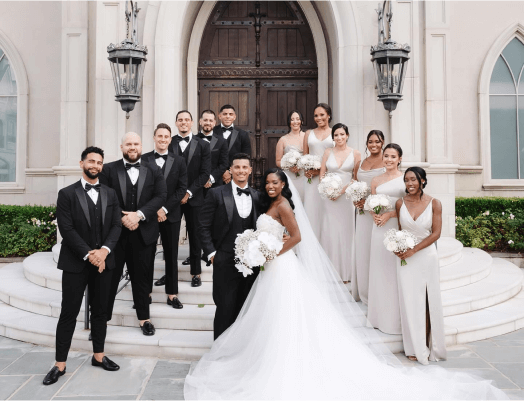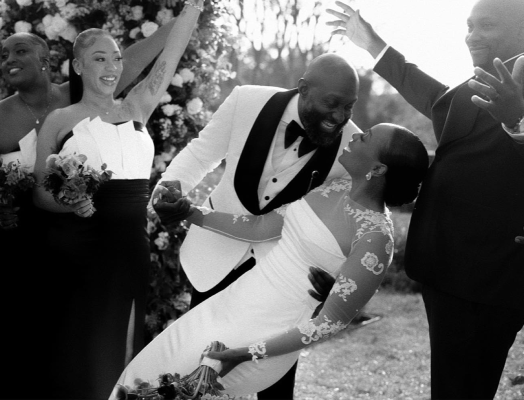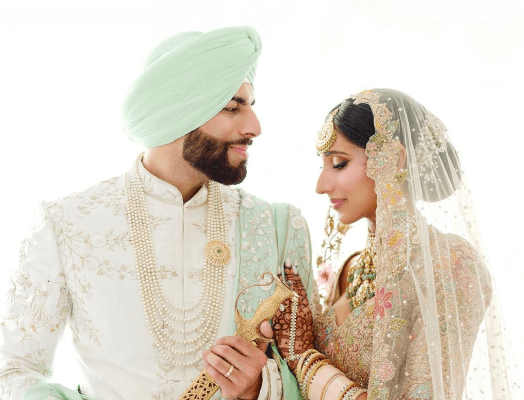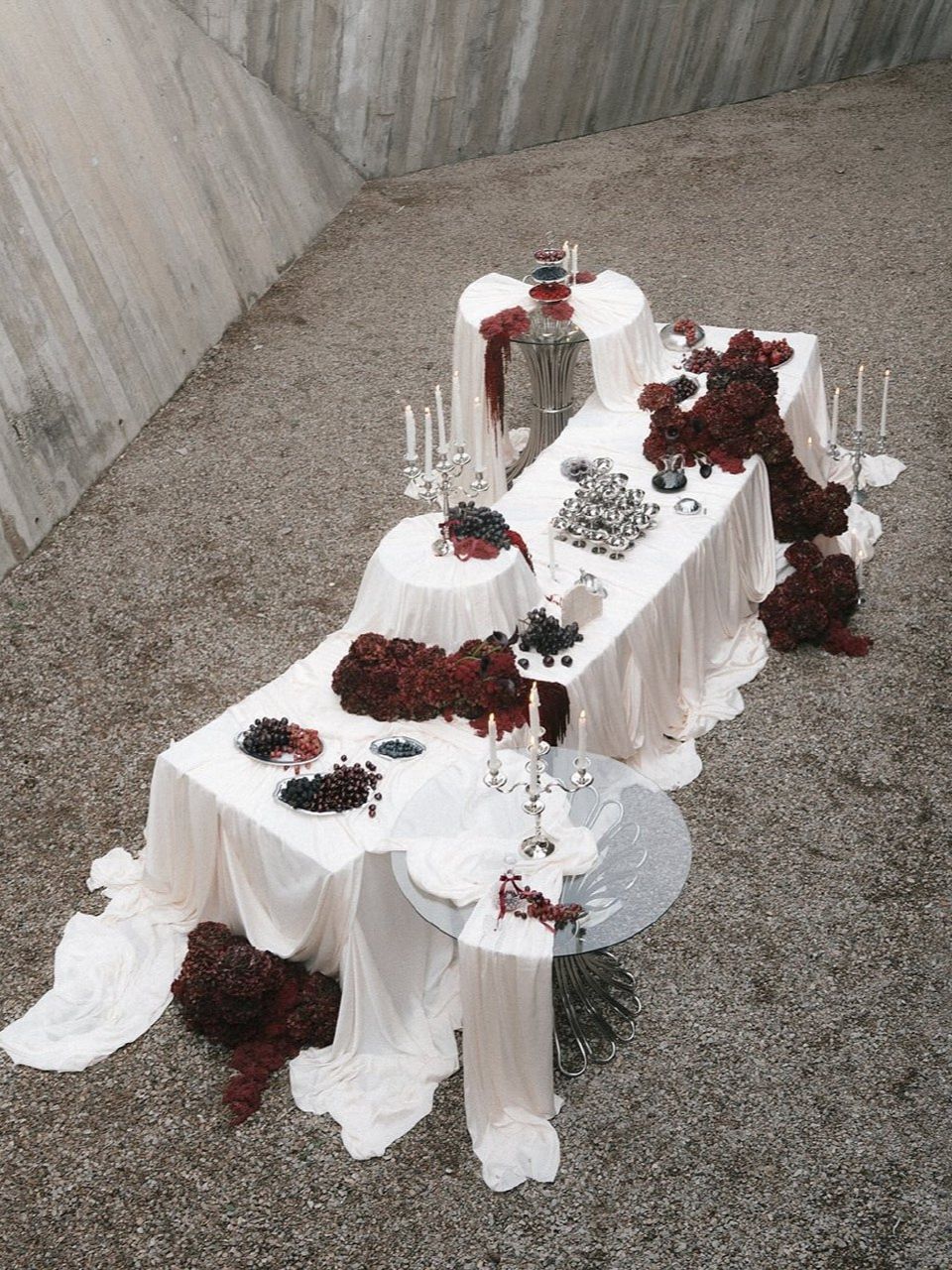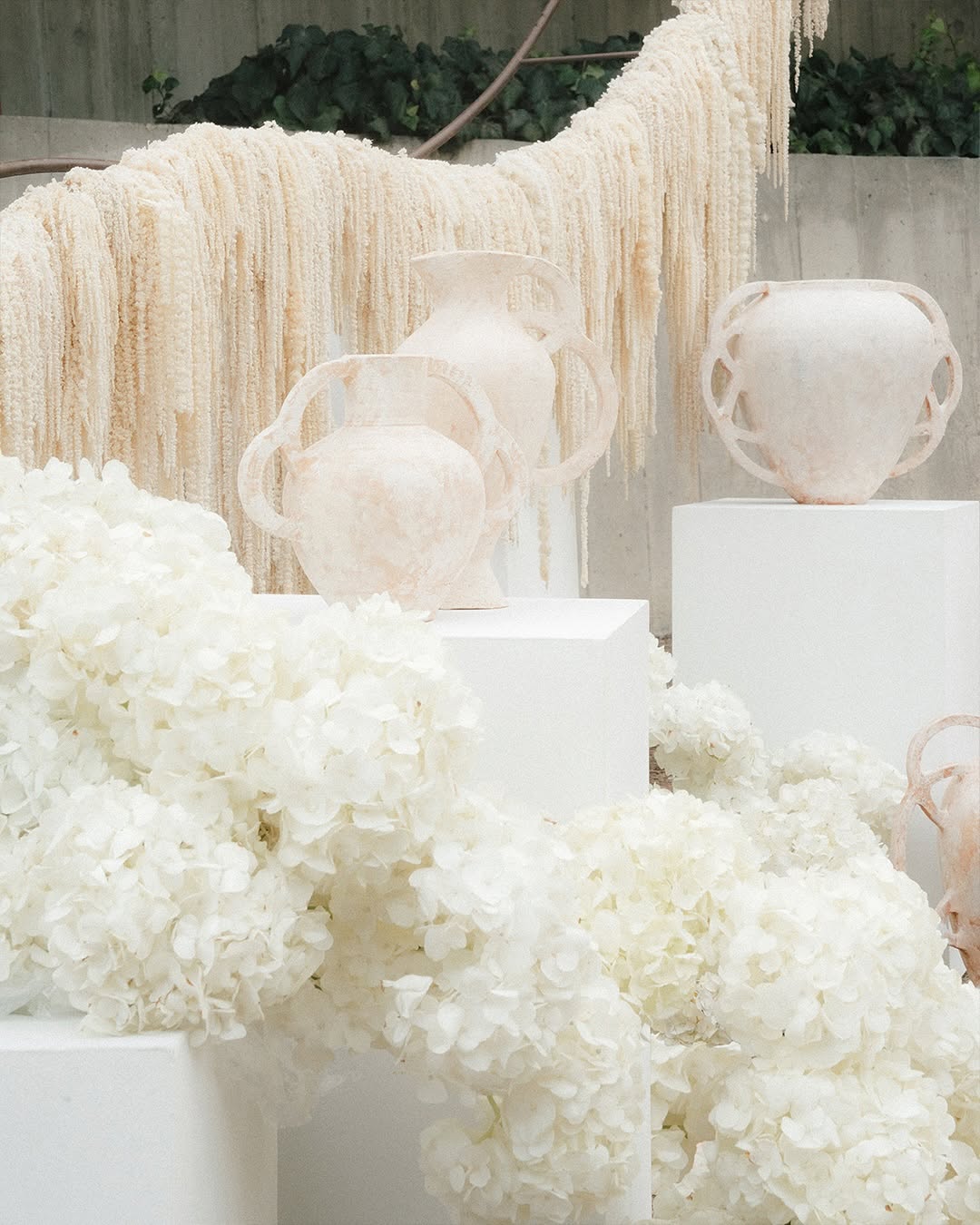The Essential Wedding Brand Guide
- Author: Natali Grace Levine
- Reading time: 7 min 14 sec
- Publication date: 04/04/2025
- Updated: 08/21/2025
Think of your wedding as your personal love story brought to life—every detail, from the invitations to the floral arrangements, should reflect who you are as a couple. Just like a brand has a unique identity, your wedding should have its own signature style that sets it apart and creates a seamless experience for you and your guests.
Your wedding brand is more than just a color palette or a pretty invitation suite. It’s the visual and emotional thread that ties everything together, making your special day feel intentional, cohesive, and undeniably you. In this wedding brand guide, we’ll break down everything you need to create a stunning and well-defined wedding brand, from selecting a theme and color palette to infusing your aesthetic into decor, invitations, and even your wedding website. Plus, we’ll sprinkle in expert tips to make the process stress-free and fun. Let’s bring your wedding vision to life!




Find Your Perfect Wedding Vendors
Step 1: Define Your Wedding Identity
Creating a wedding brand starts with understanding who you are as a couple and how you want your special day to feel. This is the foundation of your wedding’s overall aesthetic and will influence every decision you make moving forward.
Start With Your Love Story
Your wedding should be a reflection of your unique journey together. Think about what makes your relationship special and how you can incorporate that into your wedding.
- How did you meet, and what moments define your relationship?
- Do you share a favorite travel destination, song, or movie?
- What are your shared interests and values?
Tip: Write down three words that describe your relationship (e.g., adventurous, romantic, elegant). Use these words as a foundation for your branding!
Identify Your Wedding Vibe
Every wedding has a specific mood or vibe. Are you going for a timeless and elegant feel, or do you want something fun and unconventional? Identifying the feeling you want your guests to experience will help guide your branding decisions. Here are some key wedding styles to consider:
- Classic & Timeless – A black-tie affair with luxurious details, soft neutrals, and elegant calligraphy.
- Boho & Rustic – Earthy tones, wild florals, and natural elements like wood and linen.
- Modern & Minimalist – Clean lines, monochrome palettes, and contemporary aesthetics.
- Destination & Cultural – A wedding that incorporates your heritage or a travel-inspired theme.
Tip: Create a Pinterest board to gather inspiration and identify patterns in what you’re drawn to!
Define Your Wedding Priorities
Before diving into the details, take a step back and consider what matters most to you. Ask yourselves:
- What is the most important aspect of our wedding? (e.g., the venue, food, entertainment, guest experience)
- Do we want a big celebration or an intimate gathering?
- What elements are non-negotiable for us?
By focusing on what truly matters, you can ensure your branding decisions align with your vision.




Step 2: Establish Your Visual Identity
Now that you have a clear understanding of your wedding’s identity and theme, it’s time to translate that into a cohesive visual brand. This is where your wedding truly comes to life through colors, fonts, logos, and aesthetic choices that unify every design element.
Selecting Your Color Palette
Color is one of the most powerful tools in wedding branding. It sets the mood, enhances the theme, and creates a harmonious experience for guests. When choosing your wedding colors, consider factors like seasonality, venue ambiance, and your personal preferences.
A well-balanced color palette typically consists of:
- A primary color – The dominant shade that sets the overall tone.
- A secondary color – A complementary hue that adds depth.
- Accent colors – Additional shades that enhance details like flowers, stationery, and decor.
Tip: Use online color palette generators (like Coolors or Adobe Color) to test different combinations before making a final decision!
Typography & Fonts
The fonts you choose for your invitations, website, and signage contribute to your wedding's personality. There are three main categories of wedding fonts:
- Script Fonts – Elegant and romantic, perfect for formal weddings.
- Serif Fonts – Traditional and timeless, great for classic wedding branding.
- Sans-Serif Fonts – Modern and minimal, ideal for contemporary aesthetics.
Creating a Wedding Logo or Monogram
A wedding monogram or logo is a stylish way to personalize your big day. Whether it’s a simple combination of your initials, an emblem that reflects your shared passions, or an artistic interpretation of your love story, your monogram can be a signature design that appears throughout your wedding.
Your monogram can be featured on invitations, signage, and even embroidered into napkins or engraved onto keepsakes. It ties all design elements together and adds a unique, elegant flair that guests will remember. Consider collaborating with a designer or using tools like Canva to create a bespoke logo that resonates with your wedding vision.
Mood Boards: Bringing It All Together
A mood board serves as a visual representation of your wedding brand, bringing together all the elements you envision. It includes your chosen colors, fonts, textures, floral inspirations, and key aesthetic features. By creating a mood board, you ensure that every visual aspect of your wedding aligns seamlessly.
Wedding Brand Checklist
To keep your wedding branding on track, make sure you have:
- A well-defined wedding theme and mood.
- A cohesive color palette with primary and accent colors.
- Consistent typography across all printed and digital materials.
- A wedding logo or monogram for personalized details.
- A curated mood board to reference during the planning process.
- Matching decor and signage to unify the aesthetic.
- Custom elements like wedding favors, table settings, and stationery that reflect your brand.
Tip: Keep all branding assets in a digital folder for easy access and sharing with vendors!





Step 3: Infuse Your Brand Into Every Wedding Element
From the first impression your guests receive to the last dance of the night, every element should feel seamlessly tied together. A well-branded wedding is one where guests step into an atmosphere that instantly reflects your vision and personality.
Invitations and Stationery: Setting the Tone From the Start
The wedding invitation is the first glimpse your guests will have of your wedding brand, making it a crucial piece of the puzzle. Your stationery should embody your chosen aesthetic, whether through colors, typography, paper texture, or envelope detailing. From elegant calligraphy to sleek, minimalist layouts, every design choice should echo the theme and personality of your wedding. Don’t forget to extend this branding to save-the-dates, menus, place cards, and thank-you notes to create a fully cohesive experience.
Venue and Decor: Bringing Your Vision to Life
Your venue and decor are where your wedding brand comes to life in the most immersive way. Whether you are opting for a grand ballroom, an intimate vineyard, or a beachfront setting, the way you style your space should align with your branding decisions. Consider how elements like florals, tablescapes, lighting, and furniture contribute to the overall aesthetic. Everything from centerpieces to linens should work in harmony with your color palette and theme, making the atmosphere feel intentional and cohesive.
Attire and Styling: Dressing in Brand
Your attire is an extension of your wedding brand, ensuring that every visual detail aligns with your overall concept. The wedding dress, groom’s suit, bridesmaid dresses, and even guest attire can be influenced by your branding decisions. If your wedding has a vintage glam theme, art deco-inspired accessories and retro silhouettes can reinforce the aesthetic. For a beach wedding, lightweight fabrics and natural hues enhance the relaxed, airy feel. Hair, makeup, and accessories should all align with the overall brand to create a seamless look.
Guest Experience: Small Details That Make an Impact
From the moment guests arrive to the farewell send-off, every interaction they have with your wedding should reinforce the branding. Consider how your welcome signage, ceremony programs, and even cocktail napkins can subtly incorporate elements of your theme. Signature drinks, personalized favors, and even music choices can all reflect your wedding brand in unique ways.
Digital and Social Branding: A Cohesive Online Presence
In today’s world, your wedding brand extends beyond the physical celebration into the digital space. A wedding website can serve as an extension of your visual brand, mirroring the design choices of your stationery and decor. Custom hashtags, Instagram filters, and social media countdowns can all add an interactive and fun branding element that keeps guests engaged. If you’re using a wedding app for RSVPs or updates, ensure that the design and tone align with your wedding theme.
Photography and Videography: Capturing Your Brand Aesthetic
The way your wedding is documented is just as important as how it is designed. Your photographer and videographer should understand your brand’s aesthetic to ensure that the final imagery reflects your vision. If your wedding brand is soft and romantic, a photographer who specializes in dreamy, ethereal shots may be the best choice. If you prefer modern and bold branding, opt for a photographer who captures crisp, editorial-style images.





Step 4: Digital & Social Media Branding
Your wedding brand doesn’t just live in the physical space—it thrives in the digital world, too. The way you present your wedding online, from the moment you announce your engagement to the final thank-you post, should feel as cohesive and polished as the event itself.
Crafting a Wedding Website That Feels Like You
A wedding website is more than just an information hub—it’s an extension of your wedding’s personality. Think of it as a digital invitation that sets the tone for your big day. Choose a design that mirrors your wedding aesthetic, from the color scheme to the typography. Ensure your site is easy to navigate, including sections for your love story, event details, RSVP options, and travel information for guests. To make it feel even more personal, add engagement photos, a countdown timer, and a section featuring your wedding party.
Social Media Strategy: Building Anticipation & Engagement
Social media is a powerful way to get guests involved before, during, and after your wedding. A well-thought-out strategy includes:
- A unique wedding hashtag to track posts and memories shared by guests.
- Instagram-worthy save-the-dates and sneak peeks leading up to the big day.
- A private Facebook group or event page for real-time updates and coordination.
- Behind-the-scenes Instagram Stories or Reels that showcase the planning journey.
- A post-wedding recap video or slideshow to share highlights and express gratitude.
Digital Invitations & RSVP Management
For couples opting for a paperless approach, digital invitations can be both stylish and convenient. Platforms like Paperless Post and Greenvelope offer beautifully designed e-vites that align with your wedding brand. Pairing them with an online RSVP system keeps everything streamlined and organized.
Custom Filters & Interactive Guest Experience
Adding a fun, interactive element to your wedding branding can make the guest experience even more memorable. Custom Snapchat or Instagram filters, a live-streaming option for virtual guests, or an interactive wedding app with schedules and seating charts all enhance engagement and keep guests connected.







